开始前的准备工作
1、安装Xshell和Xftp

2、购买/试用/学生免费领取 阿里云服务器
服务器购买:云服务器ECS_云主机_服务器托管_弹性计算-阿里云
云产品试用:阿里云试用中心_云服务器试用_企业试用场景_开发者云产品试用
学生的学习与优惠:开发者成长计划
3、服务器初始配置
点击右上角的控制台->点击云服务器 ECS->点击实例ID。

1、创建快照
点击快照->点击创建快照。
2、修改实例名称
可改可不改。实例名称改为wu2,那么远程连接时有[root@wu2 ~]#。
3、重置服务器密码,然后用Xshell远程连接服务器
点击重置实例密码来设置服务器密码->在Xshell中通过账号(root)密码(你刚刚重置的实例密码)进行远程登录服务器。
因为阿里云上重置实例密码,它对密码的格式有要求,你重置的密码你可能记不住,那么可以在用重置的密码通过Xshell远程登录服务器后,通过passwd命令重置密码,此时对密码没有格式要求,可以写你能记住的密码,之后通过账号(root)密码(你刚刚用passwd重置的密码)进行远程登录服务器。
[root@wu2 ~]# passwd
Changing password for user root.
New password:
Retype new password:
passwd: all authentication tokens updated successfully.
Xshell中可以通过 文件->属性->外观 来设置XShell中显示的字号,我设置为14。
开始部署服务器
1、MySQL的安装和配置 + Nginx的安装
(1) MySQL的安装(rpm安装)和配置
1、rpm安装MySQL并修改MySQL密码
下载MySQL的rpm包:MySQL :: Download MySQL Yum Repository

点击No thanks, just start my download.,将mysql80-community-release-el7-3.noarch.rpm下载到本地电脑上。
下载后,用Xftp将其上传到服务器的/opt/school_linux_final_test/java下。
[root@wu2 ~]# yum install -y /opt/school_linux_final_test/java/mysql80-community-release-el7-3.noarch.rpm
[root@wu2 ~]# yum list mysql*
[root@wu2 ~]# yum install -y mysql-community-server.x86_64
[root@wu2 ~]# systemctl start mysqld
[root@wu2 ~]# systemctl status mysqld # 确保mysql已经启动
[root@wu2 ~]# mysql -V # 查看mysql版本
mysql Ver 8.0.25 for Linux on x86_64 (MySQL Community Server - GPL)
[root@wu2 ~]# grep 'password' /var/log/mysqld.log # 查看mysql初始密码
2021-05-31T07:49:15.049572Z 6 [Note] [MY-010454] [Server] A temporary password is generated for root@localhost: h9fif6176K>!
[root@wu2 ~]# mysql -u root -p
Enter password: # 密码是前面grep命令查出的密码:h9fif6176K>!
Welcome to the MySQL monitor. Commands end with ; or \g.
Your MySQL connection id is 8
Server version: 8.0.25
。。。
mysql> alter user root@localhost identified by 'a1b2c3'; # 修改密码。密码太简单,会报错,如下。
ERROR 1819 (HY000): Your password does not satisfy the current policy requirements
mysql> alter user root@localhost identified by 'Nowcoder_123'; # 修改密码,这里密码必须有大写字母,有数字,有特殊符号。
Query OK, 0 rows affected (0.01 sec)
mysql> exit
Bye
[root@wu2 ~]# mysql -u root -pNowcoder_123
mysql: [Warning] Using a password on the command line interface can be insecure.
Welcome to the MySQL monitor. Commands end with ; or \g.
Your MySQL connection id is 9
Server version: 8.0.25 MySQL Community Server - GPL
。。。
2、在服务器的MySQL里执行如下sql语句:
CREATE DATABASE `linux_test`CHARACTER SET utf8 COLLATE utf8_general_ci;
USE `linux_test`;
CREATE TABLE `linux_test`.`student`( `id` INT(11) NOT NULL AUTO_INCREMENT, `student_id` VARCHAR(50), `student_name` VARCHAR(50), PRIMARY KEY (`id`) ) ENGINE=INNODB CHARSET=utf8 COLLATE=utf8_general_ci;
INSERT INTO `linux_test`.`student` (`id`, `student_id`, `student_name`) VALUES (NULL, '2018xxxxxxxx', 'xxx');
INSERT INTO `linux_test`.`student` (`student_id`, `student_name`) VALUES ('1111', '其他学生');
(2) Nginx的安装(yum安装)
1、yum安装Nginx
[root@wu2 ~]# yum list nginx*
Loaded plugins: fastestmirror
Loading mirror speeds from cached hostfile
Available Packages
nginx.x86_64 1:1.16.1-3.el7 epel
。。。
[root@wu2 ~]# yum install -y nginx.x86_64
[root@wu2 ~]# vim /etc/nginx/nginx.conf # `/etc/nginx/nginx.conf`是nginx的配置文件
2、配置Nginx
[root@wu2 ~]# vim /etc/nginx/nginx.conf
location /index.java {
proxy_pass http://127.0.0.1:8080/;
}
location ~ \.php$ {
root /usr/share/nginx/html;
fastcgi_pass 127.0.0.1:9000; #php-fpm默认的端口是9000
fastcgi_index index.php;
fastcgi_param SCRIPT_FILENAME $document_root$fastcgi_script_name;
include fastcgi_params;
}
location ~ \.go$ {
proxy_pass http://127.0.0.1:8000;
}
location ~ \.js$ {
proxy_pass http://127.0.0.1:8001;
}
[root@wu2 ~]# service nginx restart
这里先列一下nginx的配置,在用四种语言:Java、PHP、Go、Nodejs,实现对应语言的程序后,可以通过下方网址来访问对应的程序。
| 语言 | 标准网址 | 其他网址 |
|---|---|---|
| Java | http://120.79.212.4/index.java | http://120.79.212.4:8080/ |
| PHP | http://120.79.212.4/index.php | |
| Go | http://120.79.212.4/index.go | http://120.79.212.4:8000/ 。 http://120.79.212.4/xxx.go |
| Nodejs | http://120.79.212.4/index.js | http://120.79.212.4:8001/ 。 http://120.79.212.4/xxx.js |
2、开启 阿里云安全组 和 服务器防火墙 的端口
要开启的端口有:
| 端口 | 描述 |
|---|---|
| 80 | HTTP、Nginx。 |
| 8000 | 我的测试端口,测试Go。 |
| 8001 | 我的测试端口,测试Nodejs。 |
| 8080 | Tocmat。测试Java。 |
| 9000 | 没有用到。php-fpm,PHP。 |
开启阿里云安全组的端口,可视化界面开启,举例如下:

开启服务器防火墙的端口:
[root@wu2 ~]# systemctl status firewalld # 查看防火墙状态
[root@wu2 ~]# service firewalld start # 开启防火墙
[root@wu2 ~]# firewall-cmd --zone=public --add-port=80/tcp --permanent
[root@wu2 ~]# firewall-cmd --zone=public --add-port=8000/tcp --permanent
[root@wu2 ~]# firewall-cmd --zone=public --add-port=8001/tcp --permanent
[root@wu2 ~]# firewall-cmd --zone=public --add-port=8080/tcp --permanent
[root@wu2 ~]# firewall-cmd --zone=public --add-port=9000/tcp --permanent
[root@wu2 ~]# service firewalld restart # 开放端口、移除端口后,都要重启防火墙才生效
[root@wu2 ~]# firewall-cmd --list-ports # 查看开放了哪些端口
小知识:Linux防火墙基本命令。
# 查看防火墙状态
systemctl status firewalld
# 开启、重启、关闭 防火墙
# 开启
service firewalld start
# 重启
service firewalld restart
# 关闭
service firewalld stop
# 查看防火墙规则
firewall-cmd --list-all # 查看全部信息
firewall-cmd --list-ports # 只看端口信息
# 查询端口是否开放
firewall-cmd --query-port=8080/tcp
# 开放端口、移除端口后,都要重启防火墙才生效
# 开放端口
firewall-cmd --zone=public --add-port=8080/tcp --permanent
# 移除端口
firewall-cmd --zone=public --remove-port=8080/tcp --permanent
# 命令含义:
firwall-cmd # 是Linux提供的操作firewall的一个工具
--zone # 作用域
--add-port=8080/tcp # 添加端口,格式为:端口/通讯协议
--permanent # 永久生效,没有此参数重启后失效
下面使用4种语言实现从MySQL数据库中读取数据到浏览器中显示。
1、Java
1、压缩包安装Tomcat
下载Tomcat的tar.gz压缩包Apache Tomcat® - Apache Tomcat 9 Software Downloads

把apache-tomcat-9.0.46.tar.gz上传到服务器的/opt/school_linux_final_test/java目录下。
[root@wu2 ~]# tar -zxvf /opt/school_linux_final_test/java/apache-tomcat-9.0.46.tar.gz -C /opt/school_linux_final_test/java/
[root@wu2 ~]# vim /etc/profile # 在最后追加
export PATH=$PATH:/opt/school_linux_final_test/java/apache-tomcat-9.0.46/bin
[root@wu2 ~]# source /etc/profile # 让配置文件/etc/profile生效
2、rpm安装java1.8
Java SE Development Kit 8 - Downloads

下载需要登录Oracle官网,即需要账号密码,下面是网上找的账号及密码,亲测有效。
Oracle Account:2696671285@qq.com
Oracle Password:Oracle123
把jdk-8u291-linux-x64.rpm上传到服务器的/opt/school_linux_final_test/java目录下。
[root@wu2 ~]# rpm -qa | grep jdk # 检查是否原先安装过jdk
jdk1.8-1.8.0_291-fcs.x86_64
[root@wu2 ~]# rpm -e --nodeps jdk1.8-1.8.0_291-fcs.x86_64 # 可以卸载掉原先的jdk
[root@wu2 ~]# rpm -ivh /opt/school_linux_final_test/java/jdk-8u291-linux-x64.rpm # rpm安装jdk
[root@wu2 ~]# java -version # 安装成功
java version "1.8.0_291"
Java(TM) SE Runtime Environment (build 1.8.0_291-b10)
Java HotSpot(TM) 64-Bit Server VM (build 25.291-b10, mixed mode)
[root@wu2 ~]# vim /etc/profile # 在最后追加
JAVA_HOME=/usr/java/jdk1.8.0_291-amd64
CLASSPATH=%JAVA_HOME%/lib:%JAVA_HOME%/jre/lib
PATH=$PATH:$JAVA_HOME/bin:$JAVA_HOME/jre/bin
export PATH CLASSPATH JAVA_HOME
[root@wu2 ~]# source /etc/profile # 让配置文件/etc/profile生效
3、在本地(Windows电脑上)用IDEA开发一个能实现从MySQL读取内容并显示在浏览器上的项目
pom.xml
<?xml version="1.0" encoding="UTF-8"?>
<project xmlns="http://maven.apache.org/POM/4.0.0" xmlns:xsi="http://www.w3.org/2001/XMLSchema-instance"
xsi:schemaLocation="http://maven.apache.org/POM/4.0.0 https://maven.apache.org/xsd/maven-4.0.0.xsd">
<modelVersion>4.0.0</modelVersion>
<parent>
<groupId>org.springframework.boot</groupId>
<artifactId>spring-boot-starter-parent</artifactId>
<version>2.5.0</version>
<relativePath/> <!-- lookup parent from repository -->
</parent>
<groupId>com.example</groupId>
<artifactId>demo</artifactId>
<version>0.0.1-SNAPSHOT</version>
<name>demo</name>
<description>Demo project for Spring Boot</description>
<properties>
<java.version>1.8</java.version>
</properties>
<dependencies>
<dependency>
<groupId>org.springframework.boot</groupId>
<artifactId>spring-boot-starter-web</artifactId>
</dependency>
<dependency>
<groupId>org.springframework.boot</groupId>
<artifactId>spring-boot-starter-test</artifactId>
<scope>test</scope>
</dependency>
<dependency>
<groupId>mysql</groupId>
<artifactId>mysql-connector-java</artifactId>
</dependency>
<dependency>
<groupId>org.mybatis.spring.boot</groupId>
<artifactId>mybatis-spring-boot-starter</artifactId>
<version>2.1.0</version>
</dependency>
<dependency>
<groupId>com.alibaba</groupId>
<artifactId>fastjson</artifactId>
<version>1.2.58</version>
</dependency>
</dependencies>
<build>
<plugins>
<plugin>
<groupId>org.springframework.boot</groupId>
<artifactId>spring-boot-maven-plugin</artifactId>
</plugin>
</plugins>
</build>
</project>
application.properties
# ServerProperties
server.port=8080
# ThymeleafProperties
spring.thymeleaf.cache=true
# DataSourceProperties
spring.datasource.driver-class-name=com.mysql.cj.jdbc.Driver
spring.datasource.url=jdbc:mysql://localhost:3306/linux_test?characterEncoding=utf-8&useSSL=false&serverTimezone=Hongkong
spring.datasource.username=root
spring.datasource.password=a1b2c3
spring.datasource.type=com.zaxxer.hikari.HikariDataSource
spring.datasource.hikari.maximum-pool-size=15
spring.datasource.hikari.minimum-idle=5
spring.datasource.hikari.idle-timeout=30000
# MybatisProperties
mybatis.mapper-locations=classpath:mapper/*.xml
mybatis.type-aliases-package=com.example.entity
mybatis.configuration.useGeneratedKeys=true
mybatis.configuration.mapUnderscoreToCamelCase=true
Student.java
public class Student {
private Integer id;
private String studentId;
private String studentName;
//get和set方法
}
StudentMapper.java
@Mapper
@Repository
public interface StudentMapper {
List<Student> selectStudents();
}
student-mapper.xml
<?xml version="1.0" encoding="UTF-8" ?>
<!DOCTYPE mapper
PUBLIC "-//mybatis.org//DTD Mapper 3.0//EN"
"http://mybatis.org/dtd/mybatis-3-mapper.dtd">
<mapper namespace="com.example.dao.StudentMapper">
<sql id="selectFields">
id, student_id,student_name
</sql>
<select id="selectStudents" resultType="Student">
select <include refid="selectFields"></include>
from student
</select>
</mapper>
StudentService.java
@Service
public class StudentService {
@Autowired
private StudentMapper studentMapper;
public List<Student> selectStudents() {
return studentMapper.selectStudents();
}
}
StudentController.java
@Controller
public class StudentController {
@Autowired
private StudentService studentService;
@RequestMapping(path = "/", method = RequestMethod.GET)
//@ResponseBody
public void /*List<Student>*/ selectStudents(HttpServletResponse response) {
//return studentService.selectStudents();
//使用注释掉的代码会产生问题:@ResponseBody返回JSON数据,360安全浏览器弹出下载页面_夜中听雪的博客-CSDN博客 https://blog.csdn.net/wpw2000/article/details/117430507?spm=1001.2014.3001.5502
response.setContentType("text/html;charset=utf-8");
try (
PrintWriter writer = response.getWriter();
) {
writer.write(JSON.toJSONString(studentService.selectStudents()));
} catch (IOException e) {
e.printStackTrace();
}
}
}
DemoApplication.java
@SpringBootApplication
public class DemoApplication {
public static void main(String[] args) {
SpringApplication.run(DemoApplication.class, args);
}
}
4、把本地(Windows电脑上)可以访问的SpringBoot项目部署到服务器的Tomcat上
1、修改application.properties
# DataSourceProperties # 因为访问的是你自己电脑上的mysql->服务器的mysql,可能两个mysql你设置的用户名密码不一致。
# 如:Windows电脑的MySQL密码:a1b2c3。Linux服务器上的MySQL密码:Nowcoder_123。
spring.datasource.username=root
spring.datasource.password=Nowcoder_123
2、修改pom.xml,增加<packaging>和<finalName>两行
<name>community</name>
<description>nowcoder community</description>
<packaging>war</packaging>
<build>
<finalName>ROOT</finalName>
<plugins>
<plugin>
<groupId>org.springframework.boot</groupId>
<artifactId>spring-boot-maven-plugin</artifactId>
</plugin>
</plugins>
</build>
3、增加一个类:CommunityServletInitializer
package com.example;
import org.springframework.boot.builder.SpringApplicationBuilder;
import org.springframework.boot.web.servlet.support.SpringBootServletInitializer;
public class CommunityServletInitializer extends SpringBootServletInitializer {
//tomcat访问该方法作为入口来运行该项目
@Override
protected SpringApplicationBuilder configure(SpringApplicationBuilder builder) {
return builder.sources(DemoApplication.class); //这里指出该项目的main方法所在的类
}
}
4、用maven把项目编译并且打包
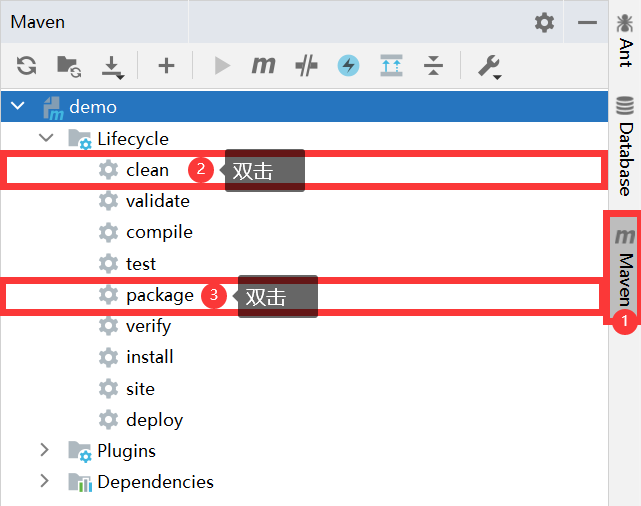
5、shutdown.sh关闭服务器tomcat,删除服务器tomcat的webapp目录下的所有文件。把本地项目目录的target目录下的ROOT.war文件上传到服务器tomcat的webapp目录下。startup.sh开启服务器tomcat。
6、此时,可以使用http://120.79.212.4:8080/访问项目。
5、配置Nginx
[root@wu2 ~]# vim /etc/nginx/nginx.conf # 增加下方内容
location /index.java {
# 注意:下方的端口号后要加"/",不然会404,因为程序的Controller里是`path = "/"`。
proxy_pass http://127.0.0.1:8080/;
}
[root@wu2 ~]# service nginx restart
此时,可以用 http://120.79.212.4/index.java 访问网页。

遇到的问题和解决方法
1、
问题:Windows上访问都没有问题,但部署到服务器后,@ResponseBody返回JSON数据,chrome浏览器显示网页,但360安全浏览器弹出下载页面。
解决方法:不使用@ResponseBody注解,而是通过response.getWriter()直接往浏览器写入JSON数据。
具体可以看我的这篇博客:@ResponseBody返回JSON数据,360安全浏览器弹出下载页面_夜中听雪的博客-CSDN博客
2、
问题:nginx的配置问题,无法通过http://120.79.212.4/index.java访问到Java。
解决方法:端口号后要加"/",像这样:proxy_pass http://127.0.0.1:8080/;。不然会404,因为程序的Controller里是path = "/"。
2、PHP
1、PHP 的 安装、配置、启动
[root@wu2 ~]# cd /opt/school_linux_final_test/php
[root@wu2 php]# wget https://www.php.net/distributions/php-7.4.5.tar.gz
[root@wu2 php]# yum install -y gcc gcc-c++ make zlib zlib-devel pcre pcre-devel libjpeg libjpeg-devel libpng libpng-devel freetype freetype-devel libxml2 libxml2-devel glibc glibc-devel glib2 glib2-devel bzip2 bzip2-devel ncurses ncurses-devel curl curl-devel e2fsprogs e2fsprogs-devel krb5 krb5-devel openssl openssl-devel openldap openldap-devel nss_ldap openldap-clients openldap-servers libsqlite3x-devel oniguruma-devel
[root@wu2 php]# tar -zxvf php-7.4.5.tar.gz
[root@wu2 php]# cd php-7.4.5
[root@wu2 php-7.4.5]# ./configure --prefix=/usr/local/php --with-config-file-path=/usr/local/php --enable-mbstring --enable-ftp --enable-gd --with-mysqli=mysqlnd --with-pdo-mysql=mysqlnd --without-pear --disable-phar --enable-sockets --with-zlib --with-xmlrpc --enable-fpm --enable-xml --enable-sockets --with-zlib --with-iconv --enable-soap --enable-pcntl --enable-cli --with-curl
[root@wu2 php-7.4.5]# make
[root@wu2 php-7.4.5]# make install
[root@wu2 php-7.4.5]# cp php.ini-production /usr/local/php/php.ini
[root@wu2 php-7.4.5]# vim /usr/local/php/php.ini
display_errors = On # Off改为On。设置让PHP错误信息打印在页面上。
[root@wu2 php-7.4.5]# cp sapi/fpm/init.d.php-fpm /etc/init.d/php-fpm
[root@wu2 php-7.4.5]# ll /etc/init.d/php-fpm
-rw-r--r-- 1 root root 2401 Jun 6 20:27 /etc/init.d/php-fpm
[root@wu2 php-7.4.5]# chmod +x /etc/init.d/php-fpm
[root@wu2 php-7.4.5]# cd /usr/local/php/etc
[root@wu2 etc]# cp php-fpm.conf.default php-fpm.conf
[root@wu2 etc]# vi php-fpm.conf
# 去掉 ";pid = run/php-fpm.pid" 前面的分号
[root@wu2 etc]# cd php-fpm.d
[root@wu2 php-fpm.d]# cp www.conf.default www.conf
[root@wu2 php-fpm.d]# vi www.conf # 修改user和group为php。
user = php
group = php
[root@wu2 php-fpm.d]# groupadd php
[root@wu2 php-fpm.d]# useradd -r -g php php
[root@wu2 php-fpm.d]# chkconfig php-fpm on # 设置开启启动
[root@wu2 ~]# /etc/init.d/php-fpm start
Starting php-fpm done
[root@wu2 ~]# ps -ef |grep php
root 25243 1 0 23:35 ? 00:00:00 php-fpm: master process (/usr/local/php/etc/php-fpm.conf)
php 25244 25243 0 23:35 ? 00:00:00 php-fpm: pool www
php 25245 25243 0 23:35 ? 00:00:00 php-fpm: pool www
root 25250 25051 0 23:35 pts/0 00:00:00 grep --color=auto php
2、配置Nginx,测试访问PHP
配置前,ip、ip/index.html、ip/index.php 都是访问不到页面的。
[root@wu2 ~]# vim /usr/share/nginx/html/index.php # 写入如下内容
<?php
phpinfo();
?>
[root@wu2 ~]# vim /etc/nginx/nginx.conf # 添加的两部分内容被"# my start"和"# my end"框了起来。
location / {
# my start
root /usr/share/nginx/html;
index index.php;
# my end
}
# my start
location ~ \.php$ {
#root html;
root /usr/share/nginx/html;
fastcgi_pass 127.0.0.1:9000; #php-fpm默认的端口是9000
fastcgi_index index.php;
fastcgi_param SCRIPT_FILENAME $document_root$fastcgi_script_name;
include fastcgi_params;
}
# my end
[root@wu2 ~]# service nginx restart
Redirecting to /bin/systemctl restart nginx.service
配置后,ip/index.php 可以访问到下方页面。
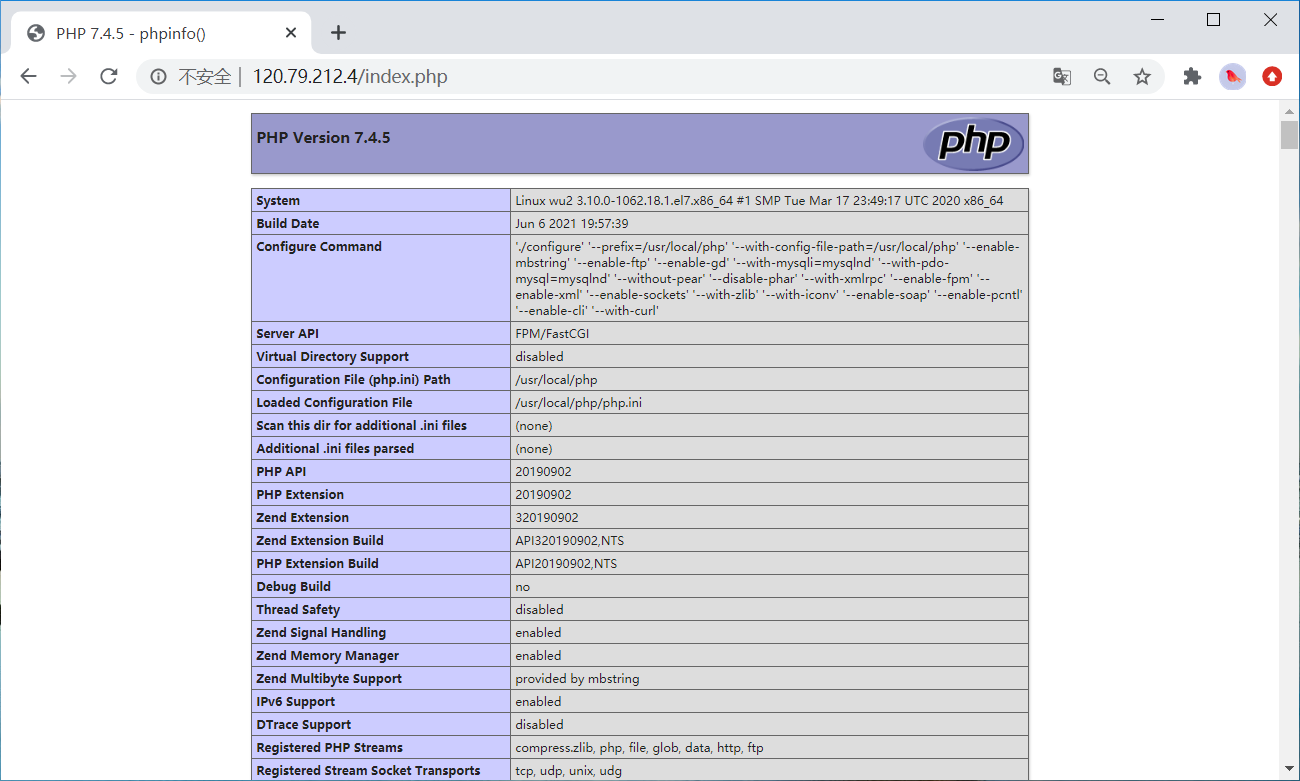
配置后,ip、ip/index.html 可以访问到下方页面。

3、用PHP语言,实现从MySQL读取内容并显示在浏览器上
[root@wu2 ~]# vim /usr/share/nginx/html/index.php # 删除原先内容,改为以下内容。
<?php
$mysql_server_name = '127.0.0.1'; // ip
$mysql_username = 'root'; // username
$mysql_password = 'Nowcoder_123'; // password
$mysql_database = 'linux_test'; // database
$conn=mysqli_connect($mysql_server_name,$mysql_username,$mysql_password,$mysql_database); //连接数据库
if ($conn -> connect_errno) {
printf("Connect failed: %s\n", $conn->connect_error);
exit();
}
//查询
$sql = "select * from student";
$query = $conn->query($sql);
//设置客户端响应头。不设也是显示网页。
//header('Content-Type:text/html;charset=utf-8');
echo "这是PHP实现的页面";
//构造表头
echo "<table border='1'><tr>";
echo "<th>id</th>";
echo "<th>学号</th>";
echo "<th>姓名</th>";
echo "</tr>";
//遍历输出
while($row = $query->fetch_array()){
echo "<tr>";
echo "<td>".$row['id']."</td>";
echo "<td>".$row['student_id']."</td>";
echo "<td>".$row['student_name']."</td>";
echo "</tr>";
}
//释放结果集+关闭MySQL连接
$query -> free_result();
$conn -> close();
?>
访问http://120.79.212.4/index.php时:
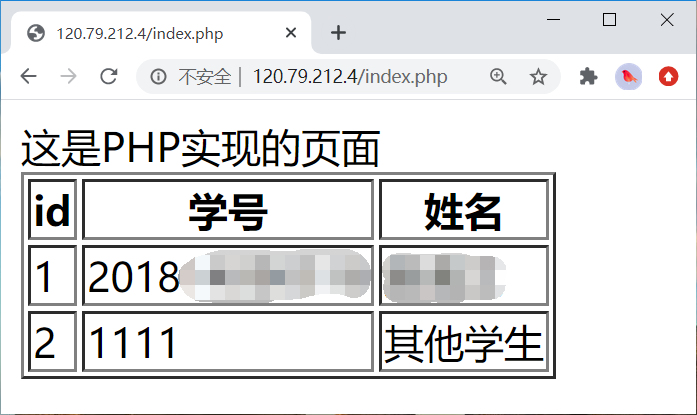
遇到的问题和解决方法
1、
问题:访问http://120.79.212.4/index.php时报错:Warning: mysqli_connect(): (HY000/2002): No such file or directory in /usr/share/nginx/html/index.php on line 7。
解决方法:把$mysql_server_name = 'localhost';改为$mysql_server_name = '127.0.0.1';
2、
问题:访问http://120.79.212.4/index.php时报错:Warning: mysqli_connect(): The server requested authentication method unknown to the client [caching_sha2_password] in /usr/share/nginx/html/index.php on line 7
原因:php还不支持mysql8.0最新的密码加密方式。
解决方法:
[root@wu2 ~]# mysql -uroot -p
Enter password:
mysql> use mysql;
mysql> ALTER USER 'root'@'localhost' IDENTIFIED WITH mysql_native_password BY 'Nowcoder_123';
mysql> exit
[root@wu2 ~]# service mysqld restart
Redirecting to /bin/systemctl restart mysqld.service
小知识:php命令:启动、停止、重启。
/etc/init.d/php-fpm start # php-fpm启动命令
/etc/init.d/php-fpm stop # php-fpm停止命令
/etc/init.d/php-fpm restart # php-fpm重启命令
ps -ef | grep php # 查看是否已经成功启动PHP
3、Go
1、Golang的安装,第一个Go程序
[root@wu2 ~]# yum list golang*
Loaded plugins: fastestmirror
Loading mirror speeds from cached hostfile
Available Packages
golang.x86_64 1.15.5-1.el7 epel
。。。
[root@wu2 ~]# yum install -y golang.x86_64
[root@wu2 ~]# go version
go version go1.15.5 linux/amd64
[root@wu2 ~]# mkdir -p /root/myLinuxTest/go/src /root/myLinuxTest/go/bin /root/myLinuxTest/go/pkg
[root@wu2 ~]# vim /etc/profile # 增加两句。配置环境变量。
export GOROOT=/usr/lib/golang
export GOPATH=/root/myLinuxTest/go
[root@wu2 ~]# source /etc/profile # 让文件生效
[root@wu2 ~]# mkdir -p /root/myLinuxTest/go/src/hello
[root@wu2 ~]# vim /root/myLinuxTest/go/src/hello/hello.go # 写入如下内容
package main
import "fmt"
func main() {
fmt.Printf("hello world\n")
}
[root@wu2 ~]# go run /root/myLinuxTest/go/src/hello/hello.go # 运行hello.go
hello world
2、用Go语言搭建简单的web服务器,即实现在浏览器上显示内容
[root@wu2 ~]# vim /root/myLinuxTest/go/src/hello/http2.go # 写入下方代码
package main
import (
"io"
"net/http"
"fmt"
)
func hello(w http.ResponseWriter, r *http.Request) {
io.WriteString(w, "Hello world!")
fmt.Fprintf(w, "Hello Wrold on client!") //这个写入到w的是输出到客户端的
fmt.Println("Hello Wrold on console!")
}
func main() {
http.HandleFunc("/", hello)
// 默认为127.0.0.1。运行后,只能在本机用"127.0.0.1:8000"访问,无法用"http://120.79.212.4:8000/"从其他电脑上访问
http.ListenAndServe(":8000", nil)
}
运行web服务,并访问。
[root@wu2 ~]# go run /root/myLinuxTest/go/src/hello/http2.go # 运行
Hello Wrold on console!

如果无法用浏览器访问,进行如下操作。
# 如果无法用浏览器访问,进行如下操作。
[root@wu2 ~]# ps -ef |grep go # 确定有该进程
root 18305 9950 0 16:54 pts/1 00:00:00 go run /root/myLinuxTest/go/src/hello/http2.go
root 18345 18305 0 16:54 pts/1 00:00:00 /tmp/go-build045791547/b001/exe/http2
root 18477 12619 0 16:57 pts/2 00:00:00 grep --color=auto go
[root@wu2 ~]# netstat -ntlp | grep 8000 # 查看8000端口是否打开
tcp6 0 0 :::8000 :::* LISTEN 18345/http2
[root@wu2 ~]# curl 127.0.0.1:8000 # curl命令会把网页的html都打印出来。用该命令确认本机能够访问该web服务。
Hello world!Hello Wrold on client!
# 本机能访问,外部无法访问时,打开阿里云安全组的相应端口和防火墙上的相应端口。
# 下面是打开防火墙端口的。
[root@wu2 ~]# firewall-cmd --zone=public --add-port=8000/tcp --permanent # 开放防火墙端口
[root@wu2 ~]# service firewalld restart # 开放端口、移除端口后,都要重启防火墙才生效
curl 的用法指南 - 阮一峰的网络日志:curl 是常用的命令行工具,用来请求 Web 服务器。它的名字就是客户端(client)的 URL 工具的意思。
3、用Go语言,实现从MySQL读取内容并显示在浏览器上
[root@wu2 ~]# go get github.com/go-sql-driver/mysql # 下载驱动包
[root@wu2 ~]# vim /root/myLinuxTest/go/src/hello/student.go # 写入如下内容
package main
import (
"fmt"
"net/http"
"log"
"database/sql"
_ "github.com/go-sql-driver/mysql"
)
func all(w http.ResponseWriter, r *http.Request) {
w.Header().Set("Content-Type", "text/html;charset=utf-8")
fmt.Fprintf(w,"这是Golang实现的页面")
//链接数据库
//用户名:密码@tcp(127.0.0.1:3306)/数据库名
db, err := sql.Open("mysql", "root:Nowcoder_123@tcp(127.0.0.1:3306)/linux_test")
if err != nil {
log.Fatal(err)
}
defer db.Close()
//查询
rows, err := db.Query("SELECT * FROM student")
if err != nil {
log.Fatal(err)
}
defer rows.Close()
//建立表头
fmt.Fprintf(w,"<table border='1'><tr>")
fmt.Fprintf(w,"<th>id</th>")
fmt.Fprintf(w,"<th>学号</th>")
fmt.Fprintf(w,"<th>姓名</th>")
fmt.Fprintf(w,"</tr>")
//遍历结果集
for rows.Next() {
var id int
var student_id string
var student_name string
if err := rows.Scan(&id,&student_id,&student_name); err != nil {
log.Fatal(err)
}
fmt.Fprintf(w,"<tr>")
fmt.Fprintf(w,"<td>%d</td>",id)
fmt.Fprintf(w,"<td>%s</td>",student_id)
fmt.Fprintf(w,"<td>%s</td>",student_name)
fmt.Fprintf(w,"</tr>")
}
if err := rows.Err(); err != nil {
log.Fatal(err)
}
}
func main() {
//设置访问的路由
http.HandleFunc("/",all)
//设置监听的端口
err := http.ListenAndServe(":8000", nil)
if err != nil {
log.Fatal("ListenAndServe: ", err)
}
}
# 下方两种运行方式,选一种就可以
[root@wu2 ~]# go run /root/myLinuxTest/go/src/hello/student.go # 前台暂时运行
[root@wu2 ~]# nohup go run /root/myLinuxTest/go/src/hello/student.go & # 后台长期运行
此时,可以用 http://120.79.212.4:8000/ 访问。
4、配置Nginx
[root@wu2 ~]# vim /etc/nginx/nginx.conf # 增加下方配置。使得访问 "ip/xxx.go" 可以访问到 "http://120.79.212.4:8000/"
location ~ \.go$ {
proxy_pass http://127.0.0.1:8000;
}
[root@wu2 ~]# service nginx restart
此时,可以用 http://120.79.212.4/index.go 访问。
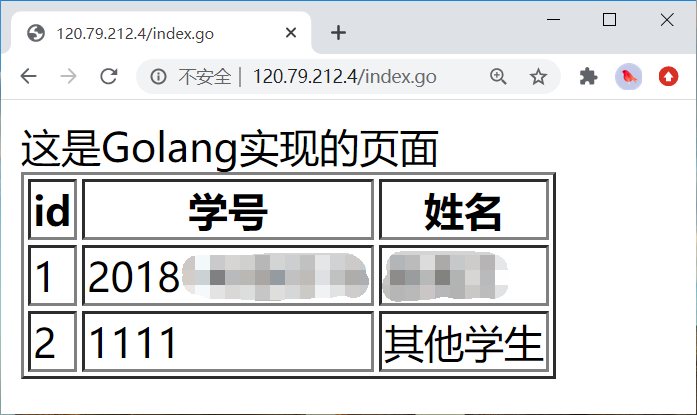
4、Nodejs
1、安装Nodejs
[root@wu2 ~]# yum list node*
Loaded plugins: fastestmirror
Loading mirror speeds from cached hostfile
Available Packages
node-gyp.noarch 0.10.6-2.el7 epel
nodejs.x86_64 1:6.17.1-1.el7 epel
[root@wu2 ~]# yum install -y nodejs.x86_64
[root@wu2 ~]# node -v
v6.17.1
2、Nodejs访问数据库
[root@wu2 ~]# cd /root/myLinuxTest/nodejs
[root@wu2 nodejs]# npm install mysql
[root@wu2 nodejs]# vim /root/myLinuxTest/nodejs/all.js # 文件写入如下内容
var mysql = require('mysql');
//创建连接
var connection = mysql.createConnection({
host : 'localhost',
user : 'root',
password : 'Nowcoder_123',
port : '3306',
database : 'linux_test'
});
//连接
connection.connect();
var sql = 'select * from student';
//开始查询
connection.query(sql,function(err,result){
if(err){
console.log('[select error] -',err.message);
return;
}
console.log(result);
});
connection.end();
[root@wu2 nodejs]# node /root/myLinuxTest/nodejs/all.js # 运行
[ RowDataPacket { id: 1, student_id: '2018xxxxxxxx', student_name: 'xxx' },
RowDataPacket { id: 2, student_id: '1111', student_name: '其他学生' } ]
3、用Nodejs语言,实现从MySQL读取内容并显示在浏览器上
[root@wu2 ~]# vim /root/myLinuxTest/nodejs/index.js
var http=require('http');
var url = require('url');
var mysql = require('mysql');
//创建连接
var connection = mysql.createConnection({
host : 'localhost',
user : 'root',
password : 'Nowcoder_123',
port : '3306',
database : 'linux_test'
});
//准备sql
var sql = 'select * from student';
//创建服务器
server = http.createServer(function(request,response) {
/*
//解析请求,包括文件名
var pathname= url.parse(request.url).pathname;
//console.log(pathname);
if(pathname !="/index.js"){
//HTTP 状态码 404 : NOT FOUND。Content Type:text/plain
response.writeHead(404,{'Content-Type': 'text/html'});
response.end("<p1>error</p1>");
return;
}
*/
//HTTP 状态码 200 : OK。Content Type:text/plain
response.writeHead(200,{'Content-Type': 'text/html'});
//向客户端输出
//开始查询
connection.query(sql,function(err,result){
if(err){
console.log('[select error] -',err.message);
return;
}
//console.log(result);
response.write(
'<!DOCTYPE html>'+
'<html lang="en">'+
'<head>'+
'<meta charset="utf-8"/>'+
'</head>');
response.write("这是Nodejs实现的页面");
//打印表头
response.write("<table border='1'><tr>");
response.write("<th>id</th>");
response.write("<th>学号</th>");
response.write("<th>姓名</th></tr>");
//遍历结果集输出
result.forEach(r =>{
response.write("<tr>");
response.write("<td>"+r.id+"</td>");
response.write("<td>"+r.student_id+"</td>");
response.write("<td>"+r.student_name+"</td>");
response.write("</tr>");
})
//发送响应数据
response.end();
});
});
server.listen(8001);
# 下方两种运行方式,选一种就可以
[root@wu2 ~]# node /root/myLinuxTest/nodejs/index.js # 前台临时运行
# 后台长期运行。使用forever来使得:nodejs 在linux上后台运行。XShell链接断开后,这个index.js程序还能运行。
[root@wu2 ~]# npm install -g forever # -g 的意思是将模块安装到全局,具体安装到磁盘哪个位置,要看 npm config prefix 的位置。
[root@wu2 ~]# forever start /root/myLinuxTest/nodejs/index.js
此时,可以用 http://120.79.212.4:8001/ 访问。
4、配置Nginx
[root@wu2 ~]# vim /etc/nginx/nginx.conf # 增加下方配置。使得访问 "ip/xxx.js" 可以访问到 "http://120.79.212.4:8001/"
location ~/index.js$ {
proxy_pass http://127.0.0.1:8001;
}
[root@wu2 ~]# service nginx restart
此时,可以用 http://120.79.212.4/index.js 访问。
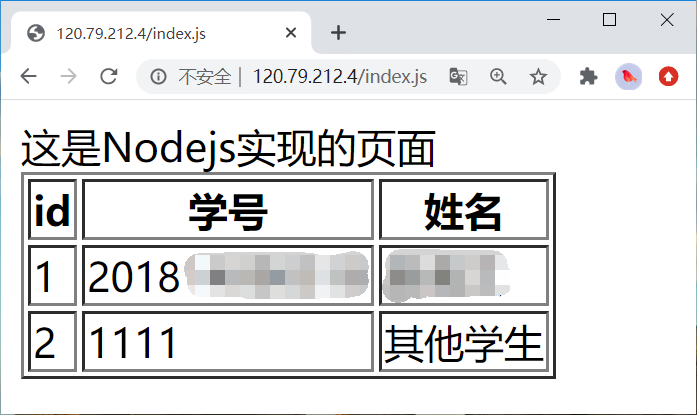
其他
1、系统架构图
Java
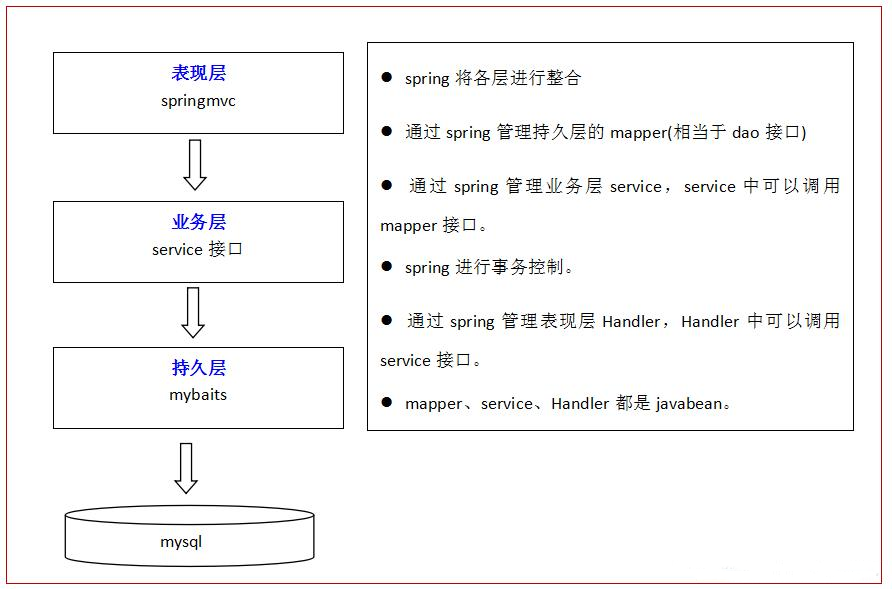
PHP

Go
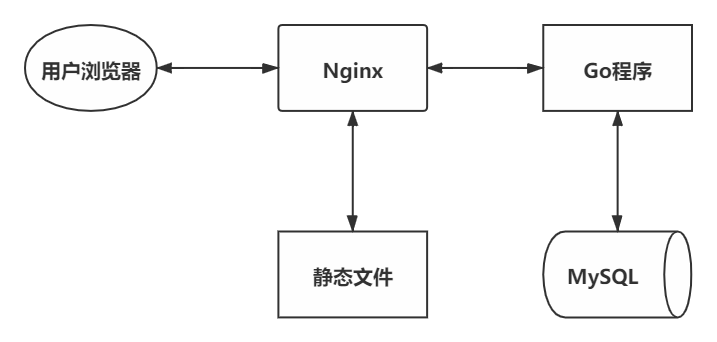
Nodejs
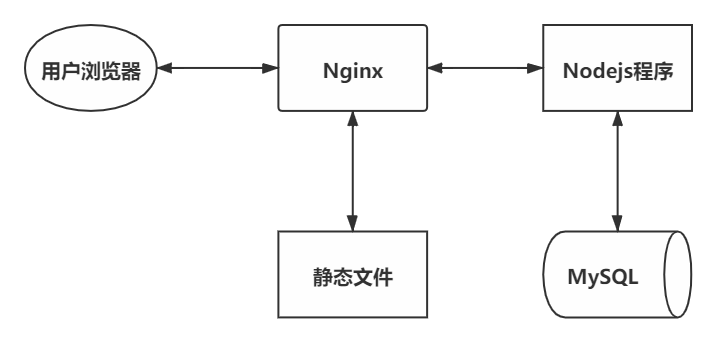
2、系统相关信息
系统发行版信息
阿里云服务器,2核4GiB,ecs.s6-c1m2.large ,华南1(深圳),深圳可用区D,CentOS7.7,64位,2021年6月30日过期。

系统IP信息

3、软件和语言的版本信息
Windows上:
IDE: IntelliJ IDEA 2020.2.3 x64
Linux服务器上:
System: CentOS7.7
Database: MySQL 8.0.25
Nginx:nginx/1.16.1
JDK: jdk1.8-1.8.0_291
Tomcat: apache-tomcat-9.0.46
PHP: php-7.4.5
Go: go1.15.5 linux/amd64
Nodejs: v6.17.1
4、其他的 遇到的问题和解决方法
1、
可以直接wget http://...这样把压缩包、rpm包直接下载到服务器上。但不知道为什么非常慢,大概每秒十几kb。所以相比起来,下载到本机,再用Xftp上传到服务器会快很多。
wget https://www.php.net/distributions/php-7.4.5.tar.gz
2、
想要维持一个长期后台运行的 logstash,你需要同时在命令前面加 nohup,后面加 &。
注意:后面加&时,需要先空上一格,再写&。不过不空格也没有什么事情。
# go程序使用这种方式没有问题,在XShell链接断开后,这个go程序还能够运行。
[root@wu2 ~]# nohup go run /root/myLinuxTest/go/src/hello/student.go &
# nodejs程序使用这种方式有问题,在XShell链接断开后,过上一会儿,这个index.js程序也不运行了。
[root@wu2 ~]# nohup node /root/myLinuxTest/nodejs/index.js &
# 所以,使用forever来使得:nodejs 在linux上后台运行。XShell链接断开后,这个index.js程序还能运行。
[root@wu2 ~]# npm install -g forever # -g 的意思是将模块安装到全局,具体安装到磁盘哪个位置,要看 npm config prefix 的位置。
[root@wu2 ~]# forever start /root/myLinuxTest/nodejs/index.js
可以通过ps命令查看进程是否启动。
[root@wu2 ~]# ps -ef |grep go
[root@wu2 ~]# ps -ef |grep node
5、总结
1、我把软件安装在/opt/school_linux_final_test下,把程序代码放在/root/myLinuxTest下。这两个文件夹下都有4个子文件夹:java、php、go、nodejs。
6、参考
Linux安装php+nginx并访问数据库+部署到web_LittleSeedling的博客-CSDN博客





















 1358
1358











 被折叠的 条评论
为什么被折叠?
被折叠的 条评论
为什么被折叠?








